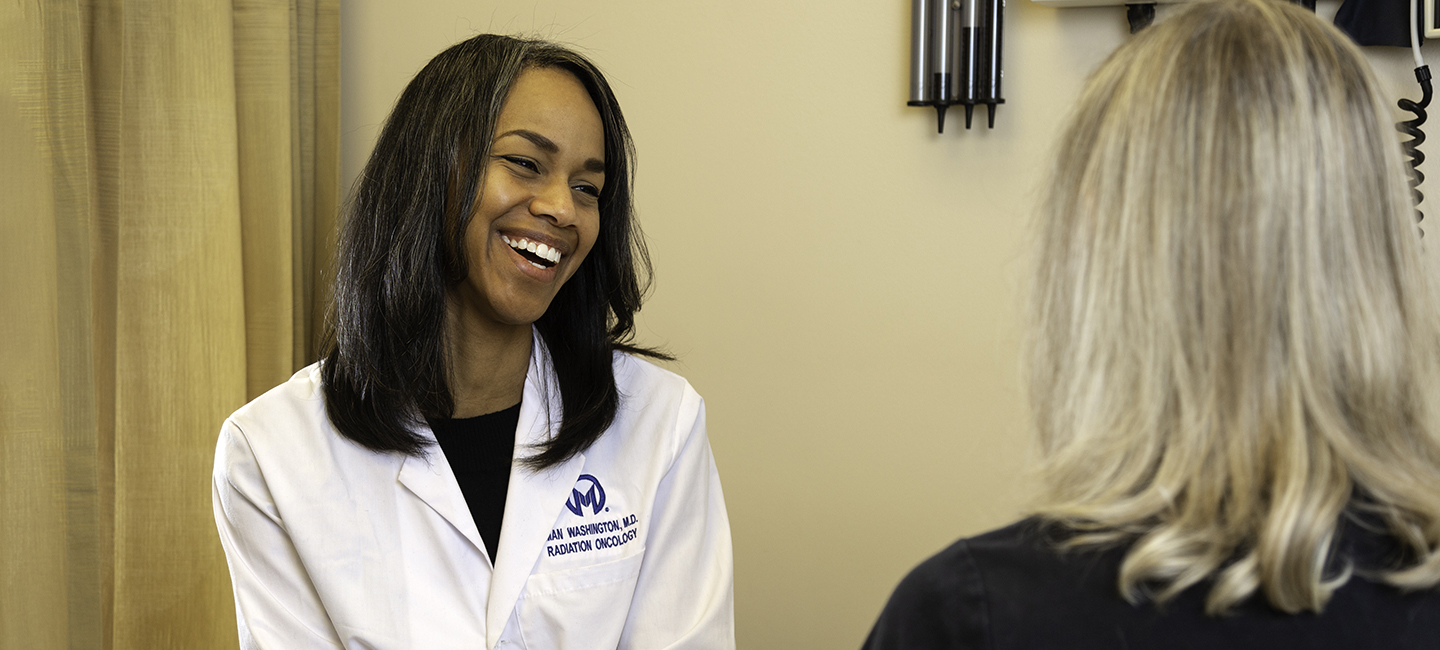Making A Difference: Spotlight on Dr. Iman Washington
Dr. Iman Washington, now a radiation oncologist in the Breast section of Moffitt’s Department of Radiation Oncology, thought of becoming a judge or a doctor as a child. She opted for the premed track in college.
While in college she also considered whether to pursue a career in the nonprofit sector. “I developed other interests in addition to medicine, including efforts to reduce the recidivism rate and to improve conditions for at-risk youth, along with improving educational resources for that population,” said Washington. “If I had chosen a different path from medicine, it probably would have been in that area.”
During time between her undergraduate studies and medical school, Washington worked as a research intern for the Safer Foundation in Chicago. The nonprofit’s vision is achieving Equal Employment Opportunities for people with criminal records, thereby transforming communities and generations. She also worked for a former professor who was writing a book on education reform.
Given her strong social conscience, her research and clinical interests that include improving cancer care for underserved populations are a natural tie-in. “I’m interested in the area of research aimed at investigating the disparities that exist for black women with breast cancer,” said Washington.
According to the National Institutes of Health, black women are less likely than white women to develop breast cancer, but they are more likely to die from it. Another serious disparity is that premenopausal black women are more likely to have triple negative breast cancer, which is a more aggressive subtype of the disease that is harder to treat than other subtypes of breast cancer.

“I’m working with colleagues to better understand why black women with triple negative breast cancer have higher rates of local regional recurrence.”
As a physician her focus is on making life better for her patients, most of whom have breast cancer. In addition to her work in eliminating cancer health disparities, Washington is interested in early and locally advanced breast cancer, metastatic breast cancer and techniques aimed at minimizing radiation-related normal tissue complications.
“I’m interested in the treatment of women with breast cancer at all stages of disease and in the methods of delivering radiation, whether that be during the planning process or treatment delivery techniques,” said Washington. “I think it’s important for us to continue to investigate ways of avoiding overtreatment and exploring different radiation treatment strategies to reduce short-term side effects as well as late complications.”
Side effects from radiation treatment can be reduced, based on the intensity of treatment itself or based on planning of the administration of treatment.
An example of planning to help reduce toxicity is utilizing prone breast position, which involves the patient lying on her stomach with the breast requiring treatment hanging away from the body. Radiation exposure can be minimized to the surrounding organs and tissues. Women with larger breasts and left side breast cancer are among the women who may benefit the most from this position. Another technique for women with left breast cancer is called the deep inspiration breath hold technique, which uses deep breaths during treatment to reduce dose to the heart.
Her work includes determining whether overall radiation treatment can be reduced for women with breast cancer who have one to three positive lymph nodes. “That is a group of women who over the years have received less surgery, but we do not know if we can administer less radiation and still obtain similar outcomes,” said Washington. “This is the objective of clinical trial CCTG MA.39, a trial that we now have open at Moffitt. If we can de-escalate radiation treatment safely, there is a potential for less side effects and better quality life for more women treated for breast cancer.”
Breast cancer radiation oncology trials led by other Moffitt physicians include determining whether women who have undergone a mastectomy, require radiation therapy and plan on reconstruction can receive reduced overall treatment time, which would eliminate almost two weeks of treatment. Another trial is looking at whether radiation therapy can be omitted for women who presented with positive axillary lymph nodes and had a complete response in the lymph nodes after neoadjuvant chemotherapy.
Washington has a confident and calming demeanor, and she likes to see that her patients are at ease. “I think radiation is less intuitive than, say, surgery for instance. So, part of communicating with them involves describing the logistics and potential side effects in detail, as well as addressing fears that arise from the unknown,” said Washington. Women who are receiving whole breast radiation therapy after a lumpectomy, and even those receiving post-mastectomy radiation therapy generally do very well with treatment. “I often hear, ‘that went by faster than I thought,’ or ‘that wasn’t as bad as I thought.’”
Over the years, radiation therapy has become more advanced. “It’s definitely changed, and often you can tell the difference,” said Washington. “For example, if a woman who had breast cancer and was treated in the late 1980s and then treated more recently to the other breast, the appearance of the two breasts is different. There are more changes to the breast that was treated decades ago.”
She offers hope to women by reminding them that radiation therapy specifically helps improve survival and reduce the likelihood of cancer returning. “I think anytime one hears the ‘C’ word, that’s a frightening thing, but most women with early-stage breast cancer have good overall survival and good cure rates,” said Washington. “I like to remind them of that, because I think that fact can get lost in all of the details of the treatment and as women are simply just trying to process the diagnosis itself. And for patients with metastatic disease that is not curable, radiation can offer palliation for sites that are causing symptoms or pain. I also believe from the standpoint of improving quality of life, radiation plays a big role for women with breast cancer.”
For her own self-care, Washington enjoys spending time with family and friends and incorporating some meditation into her week when possible. To unwind, she enjoys painting (her preferred media is acrylic). “I find it very relaxing, and I’ve done some form of art for as long as I can remember; that form of expression is an important part of who I am,” Washington said.
If an office could represent aspects of a person, Washington’s office might be such a reflection. Her office displays her creative side; a painting on one wall is done in bold red-orange shades, along with soothing lavender and green. A pillow with a flower design graces a small black rocking chair, and a decorative book sits on a side table beside a fancy glass dish filled with lavender-colored candies, evoking cordiality and hospitality. Juxtaposed along another wall, a solid bookcase contains large medical and radiation oncology books, reflective of her years of dedicated study, medical training and expertise, and ongoing commitment to the well-being of her patients.
Washington sums up her key wish for the patients she sees: “My hope for the future is that all women feel like they have the resources and the opportunity to get adequate health care and screening. Further, that all women feel that their medical community is a caring and safe place for them to receive and be active participants in their care.”


